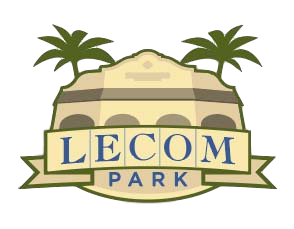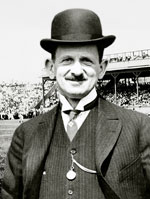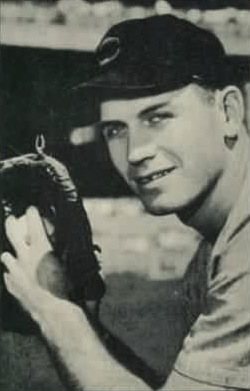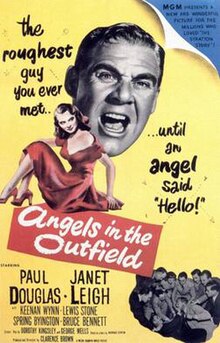
The Pittsburgh Pirates are an American professional baseball team based in Pittsburgh. The Pirates compete in Major League Baseball (MLB) as a member club of the National League (NL) Central division. Founded as part of the American Association in 1881 under the name Pittsburgh Alleghenys, the club joined the National League in 1887 and was a member of the National League East from 1969 through 1993. The Pirates have won five World Series championships, nine National League pennants, nine National League East division titles and made three appearances in the Wild Card Game.

Wrigley Field was a ballpark in Los Angeles, California. It hosted minor league baseball teams in the region for more than 30 years. It was the home park for the minor league Los Angeles Angels during their run in the Pacific Coast League, as well as for the inaugural season of the major league team of the same name in 1961. The park was designed by Zachary Taylor Davis, who had previously designed both of the Major League Baseball stadiums in Chicago: Comiskey Park and Wrigley Field. The ballpark was also used as the backdrop for several Hollywood films about baseball, as well as the 1960 TV series Home Run Derby.

Ralph McPherran Kiner was an American Major League Baseball player and broadcaster. An outfielder, Kiner played for the Pittsburgh Pirates, Chicago Cubs, and Cleveland Indians from 1946 through 1955.

Forbes Field was a baseball park in the Oakland neighborhood of Pittsburgh, Pennsylvania, from 1909 to June 28, 1970. It was the third home of the Pittsburgh Pirates, the city's Major League Baseball (MLB) team, and the first home of the Pittsburgh Steelers, the city's National Football League (NFL) franchise. From 1909 to 1924, the stadium also served as the home football field for the University of Pittsburgh "Pitt" Panthers. The stadium sat on Forbes Avenue, named for British general John Forbes, who fought in the French and Indian War and named the city in 1758.

PNC Park is a baseball stadium on the North Shore of Pittsburgh, Pennsylvania. It is the fifth home ballpark of Major League Baseball's Pittsburgh Pirates. Opened during the 2001 MLB season, PNC Park sits along the Allegheny River with a view of the Downtown Pittsburgh skyline. Constructed of steel and limestone, it has a natural grass playing surface and can seat 38,747 people for baseball. It was built just to the east of its predecessor, Three Rivers Stadium, which was demolished in 2001.

Exposition Park was the name given to three historic stadiums, located in what is today Pittsburgh, Pennsylvania. The fields were used mainly for professional baseball and American football from c. 1879 to c. 1915. The ballparks were initially located on the north side of the Allegheny River in Allegheny City, Pennsylvania. The city was annexed into Pittsburgh in 1907, which became the city's North Side, located across from Pittsburgh's downtown area. Due to flooding from the nearby river, the three stadiums' exact locations varied somewhat. The final version of the ballpark was between the eventual sites of Three Rivers Stadium and PNC Park.

Paul Douglas Fleischer, known professionally as Paul Douglas, was an American actor.
Gilmore Field was a minor league baseball park in Los Angeles, California, that served as home to the Hollywood Stars of the Pacific Coast League from 1939–1957 when they, along with their intra-city rivals, the Los Angeles Angels, were displaced by the transplanted Brooklyn Dodgers of the National League.

LECOM Park is a baseball field located in Bradenton, Florida. It is the spring training home of the Pittsburgh Pirates and is named after a 15-year naming rights deal was signed with the Lake Erie College of Osteopathic Medicine, which has its main campus in Erie, Pennsylvania, and also a campus in Bradenton. It was formerly known as McKechnie Field, named for Bradenton resident and Baseball Hall of Fame great Bill McKechnie, who led the Pirates in 1925 and the Cincinnati Reds in 1940 to World Series titles. He was also a coach with the Cleveland Indians in 1948.

Bernhard "Barney" Dreyfuss was an executive in Major League Baseball who owned the Pittsburgh Pirates franchise from 1900 to his death. He was inducted into the National Baseball Hall of Fame in 2008.

Raymond Lee Walls Jr. was an American professional baseball player, an outfielder who appeared in Major League Baseball (MLB) between 1952 and 1964 as a member of the Pittsburgh Pirates, Chicago Cubs, Cincinnati Reds, Philadelphia Phillies and Los Angeles Dodgers. He also played the 1965 season in Japan, for the Hankyu Braves. The native of San Diego threw and batted right-handed, stood 6 feet 3 inches (1.91 m) tall, and weighed 205 pounds (93 kg). Walls wore eyeglasses on the field during his active career — a rarity for players of his era — and was nicknamed "Captain Midnight" because of his eyewear.
The following is a history of the Pittsburgh Pirates of Major League Baseball.

Dee Virgil Fondy was an American professional baseball player who played first base in the Major Leagues from 1951 to 1958. He played for the Pittsburgh Pirates, Cincinnati Reds, and Chicago Cubs.
The 1952 Pittsburgh Pirates season was the team's 71st season in Major League Baseball, and their 66th season in the National League. The Pirates posted a record of 42 wins and 112 losses, their worst record since 1890, and one of the worst in major league history.

The Angels in the Outfield franchise consists of American comedy-sports films, centered around the premise and original story written by Richard Conlin. The series of films include the 1951 original film, a 1994 remake and its two made-for-television sequels which were subsequently released straight-to-home video. Each installment depicts the fictional events of struggling sports teams, who receive help from heavenly messengers, and ultimately overcome their pitfalls. The sporting events depicted in the films, include Major League Baseball and High School Football. The plot depicts the development of character and spiritual growth, that comes with the help of angels.
Bill Mazeroski's 1960 World Series home run was a baseball play that occurred in Game 7 of the 1960 World Series on October 13, 1960, at Forbes Field in Pittsburgh, Pennsylvania. Leading off the bottom of ninth, in a 9–9 tie and with the count one ball, zero strikes, Mazeroski hit a line drive toward deep left field that cleared the wall for a solo home run. Mazeroski homered off of New York Yankees pitcher Ralph Terry to end the Series, giving the Pirates a 10–9 win and their first championship since 1925. It is the only time that Game 7 has ended in a walk-off home run in World Series history.











